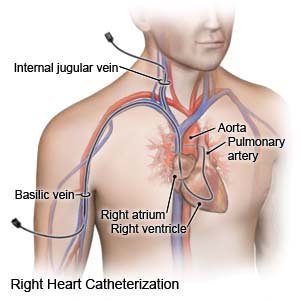Right Heart Catheterization
Medically reviewed by Drugs.com. Last updated on Apr 6, 2025.
Right heart catheterization is a procedure to check the pressure in your heart and lungs. It is also called a Swan-Ganz or pulmonary artery catheterization. You may need this procedure if you have chest pain, shortness of breath, or a heart condition. You may also need this procedure before heart surgery.
 |
DISCHARGE INSTRUCTIONS:
Call your local emergency number (911 in the US) if:
- Your catheter site does not stop bleeding even after you apply firm pressure for 10 minutes.
- You have any of the following signs of a heart attack:
- Squeezing, pressure, or pain in your chest
- You may also have any of the following:
- Discomfort or pain in your back, neck, jaw, stomach, or arm
- Shortness of breath
- Nausea or vomiting
- Lightheadedness or a sudden cold sweat
- You feel lightheaded, short of breath, or have chest pain.
- You cough up blood.
Seek care immediately if:
- The catheter site is swollen and filled with blood or is bleeding.
- The leg or arm used for the procedure becomes numb or turns white or blue.
- You have a severe headache or feel dizzy.
- You have vision changes or loss of vision.
- Your arm or leg feels warm, tender, and painful. It may look swollen and red.
Call your cardiologist or doctor if:
- You have a fever.
- The skin around your catheter site is red, swollen, or has pus coming from it.
- Your skin is itchy, swollen, or has a rash.
- You have questions or concerns about your condition or care.
Apply firm, steady pressure if bleeding continues:
A small amount of bleeding from the catheter site is possible. Apply pressure with a clean gauze or towel for 5 to 10 minutes. Call your local emergency number (911 in the US) if bleeding becomes heavy or does not stop.
Drugs used to treat this and similar conditions
Ranexa
Ranexa (ranolazine) is used to chronic treat angina (chest pain). Learn about side effects ...
Tylenol
Tylenol is a pain reliever and a fever reducer used to treat many conditions such as headaches ...
Ozempic
Learn about Ozempic (semaglutide) for type 2 diabetes treatment, weight management, cardiovascular ...
Acetaminophen/hydrocodone
The combination of hydrocodone and acetaminophen is used to relieve moderate to severe pain ...
Amlodipine
Amlodipine is a calcium channel blocker used to treat high blood pressure and angina by relaxing ...
Dilaudid
Dilaudid (hydromorphone) is a narcotic pain reliever used to treat moderate to severe pain ...
Nitrostat
Nitrostat (nitroglycerin) is used to treat a type of chest pain called angina. Includes Nitrostat ...
Isosorbide mononitrate
Isosorbide mononitrate is used to prevent angina attacks (chest pain) by dilating blood vessels ...
Acetaminophen
Acetaminophen is a widely used pain reliever and fever reducer for conditions like headaches ...
Metoprolol
Metoprolol is used to treat angina (chest pain) and hypertension (high blood pressure). Learn about ...
Care for the catheter site:
Most bandages can be removed the day after your procedure. Gently clean the catheter site with soap and water. Do not rub the site. Do not take a bath, swim, or get in a hot tub until your healthcare provider says these are okay. If you need to cough, support the catheter site with your hand.
Activity:
Rest for 1 or 2 days after your procedure. Slowly start to do more each day. Take walks around your house. Make a plan for rest during the day. Your provider will tell you when you can drive, go back to work, or do other activities. The following activity limits are based on the catheter insertion site:
- Wrist: Follow these guidelines for 1 week, or as directed.
- Do not lift anything heavier than 2 pounds.
- Do not push or pull with the arm used for the procedure.
- Avoid activities that use your arm or wrist, such as tennis, bowling, and golf.
- Groin: Follow these guidelines for as long as shown below, or as directed.
- Do not have sex for 2 days.
- Do not lift anything heavier than 5 pounds for 1 week.
- Limit stair climbing for 1 week.
- Avoid intense exercise for 2 to 4 weeks.
Drink liquids as directed:
Drink extra liquids if contrast liquid was used during your procedure. Liquid will help flush the contrast out of your body. Ask your healthcare provider how much liquid to drink each day and which liquids are best for you. Do not drink alcohol for at least 24 hours after your procedure.
Go to cardiac rehabilitation (rehab), if directed:
Your cardiologist may recommend that you attend cardiac rehab. This is a program run by specialists who will help you safely strengthen your heart and reduce the risk for more heart disease. The plan includes exercise, relaxation, stress management, and heart-healthy nutrition. Healthcare providers will also check to make sure any medicines you are taking are working.
Follow up with your cardiologist or doctor as directed:
Write down your questions so you remember to ask them during your visits.
© Copyright Merative 2025 Information is for End User's use only and may not be sold, redistributed or otherwise used for commercial purposes.
The above information is an educational aid only. It is not intended as medical advice for individual conditions or treatments. Talk to your doctor, nurse or pharmacist before following any medical regimen to see if it is safe and effective for you.
Further information
Always consult your healthcare provider to ensure the information displayed on this page applies to your personal circumstances.
